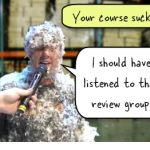Good advice! I always keep a back up too. An external drive and/or on a shared drive.
How to Organize & Manage Your E-Learning Course Files
August 31st, 2010
I was on the phone with someone who had problems with her elearning course. It seemed that nothing was working right. As I dug a little deeper, it turned out that she was deleting some of her files. She told me she did so to keep her files organized. Apparently the folders were looking a bit messy. What she didn’t realize was that all of those files she was moving and deleting actually broke her course.
My advice to her was to leave the published folders alone. In addition, we had a great conversation about file management in general. And I shared with her a few ideas so that she didn’t feel like her folders were disorganized.
Part of what I shared was that there are many ways to organize your folders and manage the elearning content. It all depends on your personal work preference, what you need to do with the files, and if you share your work with others.
Create Separate Master Folders
I like to start with a project folder that has all of my notes, resources, and production files. For example, the folder includes all PowerPoint, Quizmaker, and Engage files. I also include all of the original material from my subject matter experts.
However, I like to keep the assets (like videos and images) in separate master folders. The master folders hold all of the assets regardless of the projects they belong to. I do the same for my published courses. I like to have all of my assets and published courses in master folders so it’s easy for me to find them.

I do this because I do a lot of product and course demos. I need quick access to course assets and the published output. I don’t work with my production folders as frequently. I also don’t share my files much, so this workflow works fine for me.
But what works for me, probably doesn’t work for most people. So here’s another idea.
Keep All of the Files Together
This next approach is one that probably works best for most people. Create a single folder for each project. And inside that folder, place all of the files needed for your course. This includes your assets and published output.

With this approach, everything’s in one place, making it easy to manage and share files. In addition, products like Picasa and Windows Live Gallery allow you to tag and search for the media assets on your computer. You can also tag files in Windows Explorer. So my goal of keeping similar assets in a master folder is no longer relevant. I can just tag the assets and do a search of the tags.
Create a Generic Folder Structure
Regardless of the approach you use, it’s important to be consistent. This is especially true if you share your files with others. In fact, in a recent team meeting with the Articulate community team, we had a conversation about how we want to manage our production folders going forward since we share our files.

We opted for the all-in-one option above because it’s easier to manage and share files. We also decided on using a generic folder structure like the image above. We start with a pre-built folder structure that includes all of the key folders. When we start a project, we copy the generic folder structure, rename it, and then add our project files.
Using a consistent process means that as we collaborate and share files, we’ll always know where things are. Below is a quick tutorial that walks through the basic process we’ll be using.
Click here to view the elearning demo.
If you want additional ideas, check out Kevin Thorn’s post where he shares six tips for managing elearning courses. He covers how he manages his elearning courses and includes a quick tutorial.
Keep in mind that there’s not a right or wrong way to manage your course files. So you have the freedom to do what’s best for you. However, there are things you want to consider.
The main thing is who else gets to see and work with your files? If it’s just you, then whatever works for you is probably fine. But if you make the files available to others, then you need to consider a workflow that has more universal appeal. Not everyone can bear with our idiosyncrasies. Personally, I like a simple structure that’s not so rigid that I spend more time managing workflow than building courses.
How do you structure your folders and files? Do you have a generic folder structure to start? Share your thoughts and any tips by clicking on the comments link.
Events
- Everyday. Check out the weekly training webinars to learn more about Rise, Storyline, and instructional design.
Free E-Learning Resources
 |
 |
 |
|
Want to learn more? Check out these articles and free resources in the community. |
Here’s a great job board for e-learning, instructional design, and training jobs |
Participate in the weekly e-learning challenges to sharpen your skills |
 |
 |
 |
|
Get your free PowerPoint templates and free graphics & stock images. |
Lots of cool e-learning examples to check out and find inspiration. |
Getting Started? This e-learning 101 series and the free e-books will help. |
38 responses to “How to Organize & Manage Your E-Learning Course Files”
heh. I start with the very best of intentions. The first week of working on something has all the images in one folder, all the templates in another, videos/ animations in another. But then there will come the point where I just quickly want to test something. And I don’t realise I can create a test folder to test things in. So a bunch of files that have nothing to do with the project get mixed in with everything else. The basic structure is always retained, but figuring out what is *real* and what was just a test has caused me problems in the past. It’s something I’m trying to cure 🙂
Excellent advice, especially with not only the development and storage of Articulate objects, but with re-use and sharing as well.
Naming of these files (and folders) is also a very strong factor. Your team should determine a naming convention early on for development versions and files of all type.
Each of those considerations play a vital part (especially with Articulate dev files such as QUIZ, PPTA, PPTX, INTR) in where to put and what to name your “in development” files.
This is really critical to efficiency of work, but it’s more critical to sustainment and maintenance after you’re done.
The only thing I’d add are:
Some rules against pollution. Invariably things will show up where they aren’t supposed to. For example, within your source materials, you might see Flash FLA’s. Some folks will simply publish into that same folder and harvest for import into the assembly tools (Lectora, Articulate, etc.) This creates a problem with potential version conflicts.
We set up publish paths to go directly into the assembly product if at all possible (in Lectora that’s into the Extern or Images folder). This saves the harvesting step and reduces the possibility of version confusion and clutter.
I love the simplicity of your structure. Simple is better. We segregate folders a bit more to help work structures for larger teams. Here’s what I use:
– Planning //Storyboards and other planning artifacts
– Production
—- Prep //Raw stuff comes in here
—- Source
——- Flash
——- PhotoShop
——- Lectora
I think we could easily adopt a setup similar to yours. There are plenty of advantages to a simpler structure.
We publish directly to a Web folder for review, so each publish is live for testing and review. Once finished it’s archived into the final_product folder and tucked away in our delivered archive.
I use a version control system when I’m doing this stuff on my own. I’m used to SVN, which is easy to setup. The advantage is incremental capture of who-changed-what-when and the ability to both roll back to a change and pull down your entire archive wherever you are, even if your development machine catches fire or walks away. SVN also operates on a binary change transfer. Meaning if your PPT only changed by 15kb, that’s the amount that’s going across the wire to your SVN host.
SVN hosts can be had for between $4 / month and $20 / month with plenty of capability. GIT is another popular option. There are others. These are a godsend once you get used to the workflow (add, commit, update).
This is such good advice, Tom. I learned about consistent file structure the hard way a few years ago… I kept re-publishing but my changes weren’t appearing in the final course! You can only imagine the frustration. Lo and behold I finally realized that I was uploading one published file but had been overwriting a different one all along. whoops! Solid organization principles went into effect that day!
A consistent file structure makes replication of similar courses much easier to manage. Particularly when you are dealing with lots of assets and elements. Absolutely critical when you are working with a team but also eliminates frustration when you are a lone wolf working on lots of different projects.
Steve mentions version control in his comment above. This can be extremely important. The process used to version control should be documented. In a company that I worked for previously, we had several situations that came up, most notably with safety training, where we needed to be able to provide the exact version of a course that was in existence in the LMS at the time an employee took it. If an employee gets hurt and sues the company, your company attorneys may look to you to provide proof that the safety training was appropriate. Another employee sued the company after termination stating that she was not trained properly in her job (not safety related). If you have a situation like this and you can provide the employee’s training record and the exact version of training that she completed, your company attorneys will be your biggest fans.
Great tips! Sometimes we can get caught up in developing content that we get a bit disorganized. Having a consistent structure for storing files seems essential to good work habits and quality product. Thanks Tom.
Great advice as always Tom! And thanks for the nod!
I am passionate about this topic (almost OCD) and in my view should be mandatory in the Intsructional Design programs in universities. In fact, I’m presenting at the University of Memphis Instructional Technologies Graduate program for both semesters this year. Organizing and planning a structure is a crucial step and one I urge everyone in this buisness to develop a habit before the first document is opened.
I didn’t mention tagging in my article, but a practice I have perfected over the last several months. With the sevices you mentioned in Picasa and Windows Live Gallery, it really helps with image management. I use Adobe Bridge locally, though.
Naming conventions are key as well so files/folders line up alphabetically. Also, a simple “_v2”, “_v3”, etc. at the end of file names along with mod dates keeps everything in a neat order.
Through the Articulate Guru project I must thank the Articualte team as I ended up discovering newer methods that I added to my process…and intend on writing an article or two about it.
Thanks for the post Tom,
I would like to chime in with a couple of comments:
Regardless of which tool you use to create your e-Learning this is a very important practice. After a while of doing this you realize how important it really is to keep things in order.
When a project starts, we set up our folders right away with a consistent naming structure; that’s important because it makes it so much easier to know where to save and find different types of files.
One thing I do for every course I develop is have an IMAGES & ARTWORK folder. The ‘artwork’ part of this folder contains a PPT file… as we all know, PPT is wonderful. There isn’t a single project I work on that does not include some sort of art work that I develop in PPT. For example, some nice drop-shadow buttons (etc). I keep this ‘master’ file in that folder so if I ever need to edit my PPT artwork, it’s right there at my fingertips.
Happy developing!
Christine
Lectora Developer
Hi, Very valuable tips which helps me to think and orgainize my work in systamitic way. Thanks you very much.
This seems a little rudimentary to me…
I’m shocked that basic file management is getting kudos–where have you been the last 20 years?
Thanks for the great post! Any ideas on how to manage the numerous pdf files…Any advice on pdf managers…something that is able to take the DOI and metadata from the journal’s pdf download also and free also:) I develop a lot of e-learning content based on my readings of journal articles…and I am having a terrible time managing my pdf treasure:)
[…] or course files? The e-learning community often talks about files and project management. In fact, Tom Kuhlmann of Articulate has a new blog post today that can spark new ideas. Click the image below to learn more from […]
It looks like we use a similar system.
I just wrote a blog post on how I organize and manage my e-learning client files. (I wanted to do that after Kevin’s Forum thread, and just now got around to it.)
The file management structure I use comes from my web design days some time ago. I’ve been using it since the late 1990s, early 2000.
To learn more, visit:
http://ridgeviewmedia.com/blog/2010/08/how-to-organize-your-e-learning-project-files/
@jeff Yes! Always back up. I back up to both a flash drive and a huge 1TB external drive
@steve I put my “source” files (FLAs, layered PNGs or JPGs, etc.) inside the main asset folder (the SWF folder, the IMG folder…). I put them into a “source” subfolder within that main asset folder. But, I like your idea. As Tom says, we need to do what works for us and our teams.
@kelley I’ve been in your situation before. What we did, to play it very, very safe, was we put the date and time published into the PPT file name. In some cases, it’s better to do that to the name of the main project folder, and then archive it. Do a copy and paste of the project files and add the new/current date to revise an older project.
@Kevin Instead of using v2, v3, etc., because those tags became meaningless after awhile, we continued with adding the date and time published to the file name: Your_401k_08312010_0900am That helped Legal and Compliance departments to have a sense of comfort.
Another important factor is that with many e-Learning tools an “image” folder is automatically created for you, this is especially true if you happen to use Lectora. I make sure that I create a folder called “my_own_images” (I always adhere to the lower-case/underscore naming convention) that way I can undoubtably tell the difference between my own assetts and not confuse them with the one’s that are embedded or published with the course.
Organization is key for all of the reasons supplied by the users above. I do use a structure template, simplified for LMS uploads and versioning. Our Main Course Folder is housed on a shared/backed up drive, and I’m experimenting with the Captivate Reviewer and pushing those files out on our SharePoint site for Review/Tracking. Anyone doing this currently?
Main Course Folder
– LMS Upload (all the files needed for LMS integration, swfs, SCORM package, etc. – This is always the current version of the course…when updated, previous version is still captured in the Published Items folder)
– Working Files (PPT, Captivate)
– Source Files (original SME stuff, images, etc.)
– Published Items (swfs, html, version folders)
@ Ira…you wouldn’t believe! The issue is not so much rudimentary file management, but an acknowledgement of the way eLearning projects spiderweb out of control. A filing system that worked for a one-man shop or team of two authoring with one platform becomes cumbersome when the team increases, LMS platforms or authoring tools change. This is a great thread to see how others have managed similar file types. It’s always good to share best practices, even on something “rudimentary.”
Just yesterday I published a course as html then tested it and found that my multiple-choice quizzes were not playing properly. It turned out that the file name was too long! From now on when publishing I’ll make sure to publish to a folder that is closer to the root directory on my computer, rather than buried deep down within my data file structure.
A resource management and version control is great challenge for any multimedia project, especially for larger projects and team collaboration.
As mentioned, folder and file naming is important. I’ve found that file_v1, v2 etc nomenclature holds less relevance than file_YYMMDD. At a glance you get a meaningful statement of the version. Don’t forget the importance of setting up an Archive folder at various levels- move older file versions here to keep active folders tidy. Also easier when you may need to condense/delete/HSM archive for conservation of network drive space. (HSM: hierachical/hegemonic storage management.)
As mentioned, content currency can be crucial for some courses and there may be legislative/legal implications. Setting content build and review dates into documents can be useful (only if you do actually then review!) I’ve worked with publishing systems that enforce review dates, look forward to LMS systems that support this better also. Version control becomes crucial here and, if resources allow, using collaborative workspace technologies (such as Quickr or SharePoint) can assist with group projects and resource management.
Naming conventions based on the storyboard screen is another great way to manage assets . . . especially for updates. So, storyboard code = 211 . . . then assets named 211_1.jpg, 211_2.jpg, 211_1.wav, etc, etc.
I’ve found this invaluable when creating, processing and organizing assets. It’ especially important when working in a team environment where the designer needs to pass assets back-and-forth with the developer.
It’s all based on the storyboards though . . . shame on you if you’re not creating some sort of storyboard and storyboard naming/numbering as part of your design process. 😎
@Andy – good point about using the storyboard for naming conventions. I’ve worked on projects where every image had to be identified in the storyboard.
We have an example storyboard in our community forums: http://www.articulate.com/forums/articulate-presenter/17857-new-studio-09_need-storyboard-examples.html
Most often I see that type of board in design models where the ID passes the boards on to another designer or developer.
Thanks Tom. I had seen your screen before at a demo booth and was impressed by how much was there, yet how organized you were and could locate anything in an instant. I have started creating files similar to this, but the description here in this posting will help me to become more organized as well.
Doug, I agree. I stopped publishing to my root folder and now publish outside of my main project folder. So, I now work in 2 folders, titled:
1. Articulate Projects (this includes subfolders with all of my support files)
2. Articulate Published Projects (this includes only my published course)
Tom: How did you get the check marks to “check” in the demo. What entrance animation is that?
@Abby – those are annotations and they’re part of Presenter ’09.
Here’s a post on using them: http://www.articulate.com/blog/use-annotations-to-save-time-look-like-a-star/
And a few screencasts on using Annotations:
1. Save time with annotations in Articulate Presenter rather building animations in PowerPoint: http://screenr.com/SWN
2. How to narrate & annotate an Articulate Presenter slide, all at the same time: http://screenr.com/pJU
3. How to add multiple annotations to your presentation slides: http://screenr.com/1fC
I had a couple of thoughts:
– @Ira – Sometimes things have to be relearned as new people and new platforms come into play. Old (30 years ago) MVS systems had security and configuration management built into the tools. When PCs came into being chaos ruled until people rediscovered that they still needed the things taken for granted. Same is true for different tools.
– In addition to different versions of project files (configuration management) also keep in mind disaster recovery. What happens if/when the drive crashes or someone accidentally deletes the entire project. Sometimes this is done by systems software but it’s good to know what it is for when that day comes.
John
Great idea thank you for sharing
Great points, so critical to keep yourself organized with any type of learning, in order for your to be efficient and for it to be effective. Keep a back up!!!
I like folder structure based on workflow such as:
1. Proposals and contracts
2. Client source files
3. Storyboards
4. Interface design
5. Media development
6. Authoring
7. Published files
8. Maintenance
I find this helps when working with others and also maps pretty closely with the different roles, so sales people play in the first folder, graphic designers and flash dev play in folders 4 and 5, and ID’ers in folder 3 and so on.
My folders look pretty much like yours Tom. Thanks for the tips though.
Great tips Tom, this is very important for us in Grad School. Keeping everything organized is very essential. There are a few tips I picked up from this article that I’d like to start applying for my classes. We work on many projects throughout the semester and keeping the files in a consistent order can make or break your project. I’ve started using Google Docs as a backup for files. It’s free and allows me to access them anywhere.
I organise my files with a seperate folder for engage and quizmaker files (called Interactions) one for any flash/captivate files I include (Flash) one for images (images) and then a folder called published where I put the published folders. The presentation file (ppt) sits in the main folder for that project.
I found very early on that if you dont organise your folders, things get lost easily. I adopted this style across customer service training when I worked at O2UK, and do it still in my new job. I find its easier for me to know what I’ve done, and easier if someone else from the team comes along to edit things later.
I even created a folder structure and saved it in our base eLearning folder so all anyone needs to do is copy that folder, rename it and save the new presentation to it.
[…] default folder and this way all of my projects are structured the same way. I wrote a post on how to organize and manage your project files. That may […]
Tom:
In your tutorial, what did you use to be able to show your screen live as you narrated? Is that Screenr?
[…] e in questo modo tutti i miei progetti sono strutturati allo stesso modo. Ho scritto un post su come organizzare e gestire i file del progetto. Questo può […]
[…] How to Organize & Manage Your E-Learning Course Files Word of Mouth Blog – 20 Tips to Help You Get a Handle on Building Better E-learning Once again, it was another big week of e-learning goodness in the Articulate community. Articulate Storyline launched two weeks ago and already the Articulate community is sharing ideas, source files and tutorials for learning Storyline. If you haven’t already downloaded the free trial , now’s a good time! A Dozen Handpicked E-Learning Resources It’s hard to believe that we’re approaching the last quarter of 2010. A Simple Roadmap to Better Rapid E-Learning I get a lot of questions about how to get started with building e-learning courses. I’ve covered that a bit in previous posts on why you need to create a portfolio and simple ways to get started . I’m also a big advocate of participating in your learning community to build relationships and improve your skills . Contrast is a key part of your course design. In fact, it’s one of the foundational principles in visual design. Many people know the acronym, CRAP (or CARP if you’re an ichthyolatrist) which stands for: contrast, repetition, alignment, and proximity. […]










0
comments